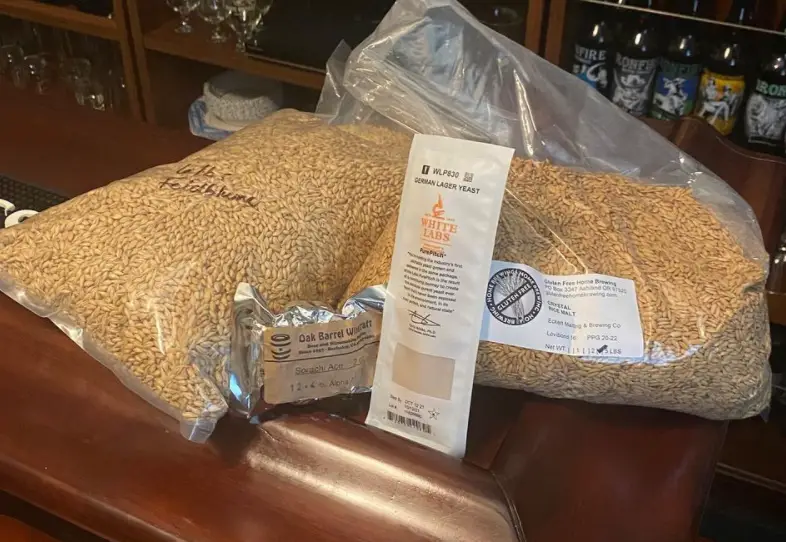
I don’t know what it is about Japanese lagers but when you step into a sushi restaurant you just feel like you need a crisp Sapporo or even a specialty craft rice pilsner. The light crisp and refreshing flavor goes well with the delicious salmon or tuna sushi.
I decided it was time to try my hand at crafting a lager in what me and my friend referred to as the lager project. For my lager I decided to make a Japanese lager but with a twist. This lager contained only craft malts. Below is the recipe I used.
- 5 lbs. Crystal Rice Malt.
- 6 lbs. Admiral Maltings-Feldblume (Continental Pilsner).
- 2 oz. Sorachi Ace.
- WLP830 White Labs German lager yeast.
- 10 cups corn sugar.
Results in a 4.2% ABV and a 24 IBU lager.
Note: Corn sugar was added because the starting gravity ended up at .28. I wanted a .42 starting gravity so I ended up adding the corn sugar. If you want a more malty beer be sure to add a few extra pounds of pilsner malt so that you can avoid the corn sugar.
Japanese Lager Style Guidelines
Japan isn’t particularly known for its beer seen. For a very long time the only style of beer that has come out of Japan are lagers, most notably Sapporo. But, that is beginning to change. Many craft beer breweries are popping up around Japan catering to craft beer drinkers.
Since the Japanese craft beer scene is so young its no wonder none of it really falls into any specific beer categories. So crafting a Japanese beer most closely falls under the international style pilsner category. The most notable attributes of a Japanese lager should be:
- Clear appearance.
- Golden color.
- Light malt aroma.
- Low hop bitterness and aroma.
- Light body.
- Most notably brewed with rice alongside malt.
Probably the most notable attribute of a Japanese lager is its sweetness that coincides with its incredibly light body. This can be achieved in many ways, but Japanese lagers achieve it with rice, that adds fermentable sugars without the heaviness of unfermentable byproducts.
Of course, low concentrations of hops also add to the light levels of bitterness.
Japanese Lager Grain Build and Malt Profile
Japanese lagers are simple, they usually have only a few malt ingredients. Pilsner malt and rice malt. What sets apart Japanese lagers is their use of local ingredients.
To honor the use of local ingredients I decided to dig deeper into the realm of craft malt and I even found a rice malt producer which is rare to find. Usually rice isn’t malted but rather rolled, which gives it less variety. Malted rice can be toasted to achieve different flavors combinations.
Barley Malt Combinations
Pilsner malt is specifically used in lager style beers for its low protein content. This leads to a lighter more refreshing beer. There are a few choices of pilsner malt that you can specifically use.
| Malt Name | Flavor Profile |
|---|---|
| Belgian Pilsner | Light color, mild malty with high enzymatic power. Low protein content |
| Craft Malt Feldblume | Golden malt, clover hay and mild scone sweetness. Great base malt for lagers. |
| Heidelberg | Low color, high enzymatic power, great for using with specialty malts. Low protein content. |
Unfortunately, due to the lack of farmland in Japan barley production is limited, however it has increase over the past 10 years. Most of the barley is grown on rice paddy fields in Hokkaido. Hence to popularity of Sapporo beer.
Since farmland is so limited and innovation has not taken place, Japan is not known for its barley. They typically produce six row grains. Thus, its impossible to find any Japanese derived barley for making a Japanese lager in the United States. Therefore we have to go with local craft or German style pilsner malts.
Rice Grain Types for Japanese Lager
Most homebrewers use rice that they have in their own house to brew beer with. In order to use it for brewing you will need to cook it like you normally would and then add it to the mash alongside your barley.
Alternatively you could use flaked rice and add it directly to the mash. Flaked rice has been rolled and so the sugars are converted during the high heat flattening process.

Both of these methods don’t give you to much variety though. But, this seems to be changing. You can now find malted rice that can be kilned and roasted in order to increase the variety of flavors in rice. This allows for an all grain beer that has a variety of flavors and is also gluten free.
As of right now the only place I have found malted rice is Gluten Free Homebrewing. These malted rice grains do come with the husk on so you will need to mill it in order to extract the sugars. Rice grains and barley grains are different sizes so you will need to adjust your grain mill accordingly.
Admiral maltings stresses the importance of minding the gap in our interview with them on craft malt tips.
Hop Quantities and Styles for Japanese Lagers
Sapporo dominates the Japanese beer market, because of this there is only one hop that Japan is known for, Sorachi Ace. This hop was developed specifically for Sapporo Breweries and is the hop of choice for Japanese lagers.
That’s not to say you can’t use other hops for your Japanese lagers in fact there are a few I wish I had used. Check them out.
| Hope Name | Description | Alpha Acids/Bitterness |
|---|---|---|
| Sorachi Ace | lemon, lime and dill aroma. Developed for Sapporo Breweries | 11.5-14.5 percent alpha acids |
| Perle | adds a floral and spicy aroma. Great for Sakura style beer. | 4.5-9 percent alpha acids |
| Saaz | finishing hop adds flora, citrus, spicy and herbal. | 2.5-4.5 percent alpha acids |
At first I wanted to add Sakura extract to my beer, but because it was my first lager I wasn’t sure how it would affect the beer, so I decided to go with a base beer. In the future I hope to add Perle and Sakura to my beer for a unique experience.
If you are using Sorachi Ace you will need less hops since the alpha acids are a bit higher, but if you combine it with Perle you could probably use 1 oz. of Sorachi and 2 oz. of Perle hops.
Directions on Brewing 5 Gallons of Japanese Lager
Brewing a Japanese lager using malted rice malt is relatively easy. If you are using rice from your kitchen you will need to cook it ahead of time.
Steps for brewing an all grain Japanese lager
- Crush your grains and be sure to mind the gap.
- Boil 7 gallons of water.
- Add 3.5 gallons of water, crushed barley and rice to mash tun.
- Mash at 168F and let sit for 30 min before sparging.
- Sparge to 6 gallons of wort.
- Bring wort to a boil and begin boiling for 60 min.
- 15 minutes to end of the boil add Sorachi Ace hops.
- At 60 minutes cool wort and pitch lager yeast.
- Check gravity and add corn sugar to reach desired gravity.
Lager Yeast and Fermentation Temperatures
Making a lager is a bit different from brewing an Ale. It requires more time and lower temperatures to get it right. This means you will likely need a fermentation chamber in order to keep your temperature low. Alternatively you can just put it out in the snow during the winter, but sadly I live in Southern California so no dice there.
There are a variety of different yeasts that you can use. Essentially all you will need is a lager yeast so feel free to experiment. I decided to go the traditional route and found a yeast that matched the International lager style.
| Yeast Name | Description | Fermentation Range |
|---|---|---|
| WLP830 German lager yeast | Medium flocculation, medium alcohol tolerance, clean flavor and aroma. | 50-55F |
| Saflager W-34/70 | High flocculation, medium alcohol tolerance, floral and fruity. | 53-59F |
| Wyeast Pilsen Lager Yeast | Medium flocculation, mild and malty, ferments dry and crisp. | 48-56F |
There are a few methods in order to lager a beer but the most common and traditional way is to ferment it at low temperatures and lager it for months.
In order to do this you will need to ferment for a week at the specified ranges and then increase the temperature into the mid 60s for 1-2 day for a diacetyl rest. At that point you will need to again drop it back down to the low 50s.
From this point there are a few schools of though. Some suggest laagering for 1 month others 3 months minimum. Lastly, a Marzen typically ferments from March until September.
Whatever you decide just remember the longer it sits at cold temperatures the cleaner and crisper it becomes. Just check out what mine looked like after 3 monthes.

Lessons Learned and Final Thoughts on Japanese Lagers
This style of beer is very interesting. It has so much potential and has yet to be further explored. In a world full of extremely hoppy beers these crisp, dry and malty beers are refreshing when enjoyed with Sushi and its ever increasing popularity.
Some things I would change with this style in the future are not using a craft base malt. Since it didn’t dry out as much as I would have liked. I would use a malted rice again, although it is rather expensive, hopefully the price will come down in the future, but it does offer an amazing flavor that you can’t find anywhere else.
Ultimately I should have used a few different types of hops and maybe added some Sakura flavor to create a unique floral light lager. However, the caramel lager turned out good on its own and had an excellent flavor. The only criticism I have is its yeasty smell, which may be caused from a lack of aroma from hops and lack of filtration.
Hopefully I have enlightened you to the wonders of Japanese style rice laagers and have encouraged you to try your hand and this delicious style.
